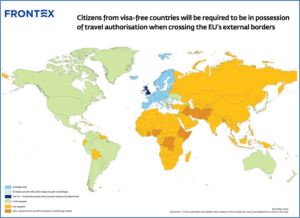By Ariana, Beatrice and Elsa
Due to increasing global mobility and security challenges, Europe has reinforced its border management strategies. The European Border and Coast Guard Agency, commonly known as Frontex, is essential to this policy. Frontex is in charge of assisting the Member States in managing the European Union’s external borders. On this subject, a new system will be implemented: the European Travel Information System (ETIAS). This new system contributes to fortifying the external European borders, and Frontex has a significant role in its implementation.
Photo: European Travel to Become Payable: EU Introduces ETIAS. Source: Collage The Gaze
The European Travel Information and Authorization System (ETIAS): a brief explanation
What is ETIAS?
ETIAS was introduced by Regulation 2018/1240. This new European travel authorization system will be implemented in 2025. It will be completed via an online application that will cost €7 for people aged 18 to 70.
This travel authorization will impose on travelers the obligation to provide personal data, including the level of education, occupation, the address of the first intended stay, and prior convictions for criminal or terrorist offenses. This data will assess the risk of the threats above and create an ETIAS watchlist concerning people at risk of committing or having committed a terrorist offense.
This new electronic authorization system is intended to apply to visa-exempt visitors from third countries traveling to a Member State of the European Union or the Schengen area (except Ireland) for less than 90 days.
European Travel Information and Authorisation System (ETIAS): In a nutshell
What is the goal of implementing ETIAS?
The European Commission aims to strengthen controls at the external borders to preserve freedom of movement within the internal market and, more generally, the Schengen area.
The establishment of ETIAS answers several objectives. This system has been designed to reinforce security at the borders, especially against terrorism and irregular immigration. By conducting security risk assessments of visitors before their arrival at the border, the goal is to prevent potential threats, even potential epidemic threats, from entering the Schengen area.
Moreover, this system aims to support the objectives of the Schengen Information System (SIS), the platform Schengen area members utilize to exchange real-time data on individuals and objects of interest. ETIAS will contribute to preventing, detecting, and investigating terrorist offenses and serious criminal activities.
Finally, the other purpose of ETIAS is to streamline border management to facilitate legitimate travel.
How will ETIAS work?
ETIAS is an automated IT system that performs tasks or processes automatically without continuous human intervention. ETIAS will use artificial intelligence (AI) to analyze applications from third-country nationals wishing to stay in the Schengen area for less than 90 days. Nationals from the 60 countries covered by ETIAS will have their applications automatically analyzed by various European databases, such as Frontex or Europol, to ensure they do not constitute a threat. Applicants will mostly receive an answer in less than an hour, but it could take up to a month. Frontex has stated that, on average, 97% of applications would receive rapid authorization. Regarding the remaining 3%, these applications will be reviewed manually by the ETIAS Central Unit. Frontex is responsible for setting up and operating this Central Unit.
ETIAS, THE ELECTRONIC TRAVEL AUTHORISATION FOR EUROPE
The Role of Frontex…
Frontex, created in 2004, is one of the most critical European agencies. Its relevance has grown over the years and, with a budget of over 845 million euros in 2023, plays a crucial role in enforcing EU borders policy. This European agency provides support to Member States in their efforts to control and secure the external borders of the Schengen. Therefore, it is logical that Frontex plays a pivotal role in enforcing ETIAS.
…in enforcing ETIAS
According to Article 7 of the ETIAS Regulation, Frontex is responsible for setting up and operating the ETIAS Central Unit. This Unit is within Frontex’s organization and manages ETIAS.
Frontex
First, concerning online application provided by the travelers. During the processing of the data sent by the applicant, if there is a hit, the ETIAS Central Unit will have the responsibility to cross-check the information of the person in question against the information contained in the Central System. Information encloses in the Central System include other EU information systems, Europol, and Interpol data. This will allow the Central Unit to determine whether the applicant is welcome in the Schengen area.
Frontex is further tasked with performing audits of the processing of applications to safeguard fundamental rights in this process. In doing this, Frontex agents will have to examine how the continental Unit manages online applications’ fundamental rights, such as the right to privacy and non-discrimination. The ETIAS central unit must respect these rights throughout the data analysis process but also subsequently regarding their storage.
Frontex officials are responsible for ensuring the data entered in application files is up to date. The Central Unit is tasked with publishing an annual activity report containing statistical data on ETIAS’s functioning and general information on its activities, activities, and concerns. The report is made to the European Parliament, the Council, and the Commission.
One of the most critical tasks of Frontex is that it is charged with defining, revising, and deleting, as well as assessing risk indicators to ensure the security of Europe’s borders, according to Article 33 of the ETIAS Regulation. These risk indicators are listed in Recital 27 of the ETIAS regulation and relate to threats regarding security, irregular immigration, or high epidemic risks. The risk indicators are based on the factors provided by the ETIAS online application, which include nationality, residence, education, and employment status. Those criteria have been chosen to avoid discrimination. Applications will be automatically checked against this list of risk indicators. If a hit is triggered, the Central Unit cross-checks this(/these) hit(s) against other databases and, depending on the result, either issues a travel authorization or refers the case to a competent Member State authority, who will manually process the information and either grant or refuse the travel authorization. This meticulous process ensures that ETIAS balances security concerns with respect for individual rights and non-discrimination principles.



